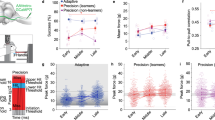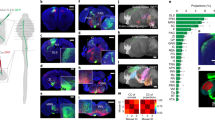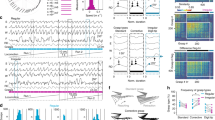Abstract
Motor learning is accompanied by widespread changes within the motor cortex, but it is unknown whether these changes are ultimately funneled through a stable corticospinal output channel or whether the corticospinal output itself is plastic. We investigated the consistency of the relationship between corticospinal neuron activity and movement through in vivo two-photon calcium imaging in mice learning a lever-press task. Corticospinal neurons exhibited heterogeneous correlations with movement, with the majority of movement-modulated neurons decreasing activity during movement. Individual cells changed their activity across days, which led to changed associations between corticospinal activity and movement. Unlike previous observations in layer 2/3, activity accompanying learned movements did not become more consistent with learning; instead, the activity of dissimilar movements became more decorrelated. These results indicate that the relationship between corticospinal activity and movement is dynamic and that the types of activity and plasticity are different from and possibly complementary to those in layer 2/3.
This is a preview of subscription content, access via your institution
Access options
Access Nature and 54 other Nature Portfolio journals
Get Nature+, our best-value online-access subscription
$29.99 / 30 days
cancel any time
Subscribe to this journal
Receive 12 print issues and online access
$209.00 per year
only $17.42 per issue
Buy this article
- Purchase on Springer Link
- Instant access to full article PDF
Prices may be subject to local taxes which are calculated during checkout







Similar content being viewed by others
References
Heffner, R. & Masterton, B. Variation in form of the pyramidal tract and its relationship to digital dexterity. Brain Behav. Evol. 12, 161–200 (1975).
Armand, J. The origin, course and terminations of corticospinal fibers in various mammals. Prog. Brain Res. 57, 329–360 (1982).
Oswald, M.J., Tantirigama, M.L.S., Sonntag, I., Hughes, S.M. & Empson, R.M. Diversity of layer 5 projection neurons in the mouse motor cortex. Front. Cell. Neurosci. 7, 174 (2013).
Evarts, E.V. Relation of pyramidal tract activity to force exerted during voluntary movement. J. Neurophysiol. 31, 14–27 (1968).
Isomura, Y., Harukuni, R., Takekawa, T., Aizawa, H. & Fukai, T. Microcircuitry coordination of cortical motor information in self-initiation of voluntary movements. Nat. Neurosci. 12, 1586–1593 (2009).
Churchland, M.M. et al. Neural population dynamics during reaching. Nature 487, 51–56 (2012).
Sanes, J.N. & Donoghue, J.P. Plasticity and primary motor cortex. Annu. Rev. Neurosci. 23, 393–415 (2000).
Kawai, R. et al. Motor cortex is required for learning but not for executing a motor skill. Neuron 86, 800–812 (2015).
Guo, J.-Z. et al. Cortex commands the performance of skilled movement. Elife 4, e10774 (2015).
Ramanathan, D., Conner, J.M. & Tuszynski, M.H. A form of motor cortical plasticity that correlates with recovery of function after brain injury. Proc. Natl. Acad. Sci. USA 103, 11370–11375 (2006).
Whishaw, I.Q., Pellis, S.M., Gorny, B., Kolb, B. & Tetzlaff, W. Proximal and distal impairments in rat forelimb use in reaching follow unilateral pyramidal tract lesions. Behav. Brain Res. 56, 59–76 (1993).
Kleim, J.A., Barbay, S. & Nudo, R.J. Functional reorganization of the rat motor cortex following motor skill learning. J. Neurophysiol. 80, 3321–3325 (1998).
Kargo, W.J. & Nitz, D.A. Improvements in the signal-to-noise ratio of motor cortex cells distinguish early versus late phases of motor skill learning. J. Neurosci. 24, 5560–5569 (2004).
Xu, T. et al. Rapid formation and selective stabilization of synapses for enduring motor memories. Nature 462, 915–919 (2009).
Yang, G., Pan, F. & Gan, W.-B. Stably maintained dendritic spines are associated with lifelong memories. Nature 462, 920–924 (2009).
Graziano, M.S.A. Ethological action maps: a paradigm shift for the motor cortex. Trends Cogn. Sci. 20, 121–132 (2016).
Biane, J.S., Takashima, Y., Scanziani, M., Conner, J.M. & Tuszynski, M.H. Thalamocortical projections onto behaviorally relevant neurons exhibit plasticity during adult motor learning. Neuron 89, 1173–1179 (2016).
Rioult-Pedotti, M.-S., Friedman, D., Hess, G. & Donoghue, J.P. Strengthening of horizontal cortical connections following skill learning. Nat. Neurosci. 1, 230–234 (1998).
Peters, A.J., Chen, S.X. & Komiyama, T. Emergence of reproducible spatiotemporal activity during motor learning. Nature 510, 263–267 (2014).
Wang, L., Conner, J.M., Rickert, J. & Tuszynski, M.H. Structural plasticity within highly specific neuronal populations identifies a unique parcellation of motor learning in the adult brain. Proc. Natl. Acad. Sci. USA 108, 2545–2550 (2011).
Chen, S.X., Kim, A.N., Peters, A.J. & Komiyama, T. Subtype-specific plasticity of inhibitory circuits in motor cortex during motor learning. Nat. Neurosci. 18, 1109–1115 (2015).
Koralek, A.C., Jin, X., Long, J.D., II, Costa, R.M. & Carmena, J.M. Corticostriatal plasticity is necessary for learning intentional neuroprosthetic skills. Nature 483, 331–335 (2012).
Kargo, W.J. & Nitz, D.A. Early skill learning is expressed through selection and tuning of cortically represented muscle synergies. J. Neurosci. 23, 11255–11269 (2003).
Masamizu, Y. et al. Two distinct layer-specific dynamics of cortical ensembles during learning of a motor task. Nat. Neurosci. 17, 987–994 (2014).
Costa, R.M., Cohen, D. & Nicolelis, M.A. Differential corticostriatal plasticity during fast and slow motor skill learning in mice. Curr. Biol. 14, 1124–1134 (2004).
Nishimura, Y., Perlmutter, S.I., Eaton, R.W. & Fetz, E.E. Spike-timing-dependent plasticity in primate corticospinal connections induced during free behavior. Neuron 80, 1301–1309 (2013).
Chen, T.-W. et al. Ultrasensitive fluorescent proteins for imaging neuronal activity. Nature 499, 295–300 (2013).
Wahl, A.S. et al. Neuronal repair. Asynchronous therapy restores motor control by rewiring of the rat corticospinal tract after stroke. Science 344, 1250–1255 (2014).
Bácskai, T. et al. Musculotopic organization of the motor neurons supplying forelimb and shoulder girdle muscles in the mouse. Brain Struct. Funct. 218, 221–238 (2013).
Kuang, R.Z. & Kalil, K. Branching patterns of corticospinal axon arbors in the rodent. J. Comp. Neurol. 292, 585–598 (1990).
Terashima, T. Anatomy, development and lesion-induced plasticity of rodent corticospinal tract. Neurosci. Res. 22, 139–161 (1995).
Kita, T. & Kita, H. The subthalamic nucleus is one of multiple innervation sites for long-range corticofugal axons: a single-axon tracing study in the rat. J. Neurosci. 32, 5990–5999 (2012).
Schiller, J., Helmchen, F. & Sakmann, B. Spatial profile of dendritic calcium transients evoked by action potentials in rat neocortical pyramidal neurones. J. Physiol. (Lond.) 487, 583–600 (1995).
Hill, D.N., Varga, Z., Jia, H., Sakmann, B. & Konnerth, A. Multibranch activity in basal and tuft dendrites during firing of layer 5 cortical neurons in vivo. Proc. Natl. Acad. Sci. USA 110, 13618–13623 (2013).
Mittmann, W. et al. Two-photon calcium imaging of evoked activity from L5 somatosensory neurons in vivo. Nat. Neurosci. 14, 1089–1093 (2011).
Evarts, E.V. Relation of discharge frequency to conduction velocity in pyramidal tract neurons. J. Neurophysiol. 28, 216–228 (1965).
Suter, B.A., Migliore, M. & Shepherd, G.M.G. Intrinsic electrophysiology of mouse corticospinal neurons: a class-specific triad of spike-related properties. Cereb. Cortex 23, 1965–1977 (2013).
Tseng, G.F. & Prince, D.A. Heterogeneity of rat corticospinal neurons. J. Comp. Neurol. 335, 92–108 (1993).
Schiemann, J. et al. Cellular mechanisms underlying behavioral state-dependent bidirectional modulation of motor cortex output. Cell Rep. 11, 1319–1330 (2015).
Quallo, M.M., Kraskov, A. & Lemon, R.N. The activity of primary motor cortex corticospinal neurons during tool use by macaque monkeys. J. Neurosci. 32, 17351–17364 (2012).
Ebbesen, C.L., Doron, G., Lenschow, C. & Brecht, M. Vibrissa motor cortex activity suppresses contralateral whisking behavior. Nat. Neurosci. 20, 82–89 (2017).
Kaufman, M.T., Churchland, M.M., Ryu, S.I. & Shenoy, K.V. Cortical activity in the null space: permitting preparation without movement. Nat. Neurosci. 17, 440–448 (2014).
Ganguly, K., Dimitrov, D.F., Wallis, J.D. & Carmena, J.M. Reversible large-scale modification of cortical networks during neuroprosthetic control. Nat. Neurosci. 14, 662–667 (2011).
Kakei, S., Hoffman, D.S. & Strick, P.L. Muscle and movement representations in the primary motor cortex. Science 285, 2136–2139 (1999).
Griffin, D.M., Hoffman, D.S. & Strick, P.L. Corticomotoneuronal cells are “functionally tuned”. Science 350, 667–670 (2015).
Davidson, A.G., Chan, V., O'Dell, R. & Schieber, M.H. Rapid changes in throughput from single motor cortex neurons to muscle activity. Science 318, 1934–1937 (2007).
Liberti, W.A. III et al. Unstable neurons underlie a stable learned behavior. Nat. Neurosci. 19, 1665–1671 (2016).
Brus-Ramer, M., Carmel, J.B., Chakrabarty, S. & Martin, J.H. Electrical stimulation of spared corticospinal axons augments connections with ipsilateral spinal motor circuits after injury. J. Neurosci. 27, 13793–13801 (2007).
Iriki, A., Keller, A., Pavlides, C. & Asanuma, H. Long-lasting facilitation of pyramidal tract input to spinal interneurons. Neuroreport 1, 157–160 (1990).
Mosberger, A.C. et al. Axotomized corticospinal neurons increase supra-lesional innervation and remain crucial for skilled reaching after bilateral pyramidotomy. Cereb. Cortex https://dx.doi.org/10.1093/cercor/bhw405 (2017).
Tennant, K.A. et al. The organization of the forelimb representation of the C57BL/6 mouse motor cortex as defined by intracortical microstimulation and cytoarchitecture. Cereb. Cortex 21, 865–876 (2011).
Acknowledgements
We thank A. Kim, T. Loveland and L. Hall for technical assistance and thank current and former members of the Komiyama lab, especially S. Chen, J. Dahlen, B. Danskin and H. Liu, for comments and discussions. This research was supported by grants from NIH (R01 DC014690-01, R21 DC012641, R01 NS091010A, U01 NS094342 and R01 EY025349), Human Frontier Science Program, Japan Science and Technology Agency (PRESTO), New York Stem Cell Foundation, David & Lucile Packard Foundation, Pew Charitable Trusts and McKnight Foundation to T.K. A.J.P. was supported by the Neuroplasticity of Aging Training Grant (AG000216), a Newton International fellowship, a Human Frontier Science Program fellowship and an EMBO fellowship. J.L. was supported by the Swiss National Science Foundation.
Author information
Authors and Affiliations
Contributions
Conceptualization, A.J.P. and T.K.; methodology for spinal cord injections and histology investigation, J.L.; longitudinal simultaneous dendrite and soma imaging, N.G.H. and K.O′N.; other methodology and investigation, A.J.P.; software and writing for the original draft, A.J.P.; analysis, A.J.P. and T.K.; writing review and editing, A.J.P. and T.K.; supervision and funding acquisition, T.K.
Corresponding author
Ethics declarations
Competing interests
The authors declare no competing financial interests.
Integrated supplementary information
Supplementary Figure 1 Semi-simultaneous imaging of sparse somata and apical dendrites
Sparsely-labelled corticospinal neurons semi-simultaneously imaged at their apical dendrites (left pictures) and somata (center pictures). Red scale bars are 13 μm. Right column is fluorescence traces from apical dendrites (black) and somata (red) indicated by the blue circles within each picture and min-max normalized. Multiple black traces within one cell indicate visually-confirmed sibling dendritic branches. Dendritic calcium signals across sibling branches are highly correlated with somatic calcium signals.
Supplementary Figure 2 Example event detection
Top: example fluorescence trace (black) and detected events (red, Methods). Events are detected during the rise of the trace, even when it is during decay of a large preceding event. Bottom: example fluorescence traces (black) and detected events (red) of 10 simultaneously imaged cells across an entire imaging session.
Supplementary Figure 3 Movement correlations across days by animal
Median correlations between rewarded movements of all pairs of days as in Fig. 3c for each animal individually.
Supplementary Figure 4 Semi-simultaneous imaging of somata and dendrites across learning
(a) Corticospinal cells that were imaged at the dendrite and soma semi-simultaneously across learning. Left images: side projections. Right images: slices from analyzed depths indicated by black lines. Arrows point towards analyzed dendrites and somata.
(b) Min-max normalized fluorescence traces of semi-simultaneously imaged dendrites (black) and corresponding somata (red) across days. Fluorescence events are closely coupled between dendrites and somata throughout learning.
Supplementary Figure 5 Activity- and movement-related classification of layer 2/3 cells
Re-analysis of data from19.
(a) Activity of all cells aligned to movement onset and offset, equivalent to Fig. 4b for layer 2/3 cells. Top: activity of all recorded cells in all animals min-max normalized within day then averaged across days, sorted by the coefficient of the first principal component of average activity across cells (1122 cells). Bottom: average activity across all cells, then averaged across animals. Error bars are s.e.m. across animals.
(b) Average activity of all classified active cells aligned to movement onset and offset, equivalent to Fig. 4c for layer 2/3 cells. Top: activity of all recorded cells that fell into each category on at least one day, min-max normalized within day and then averaged across days with that classification, sorted by the coefficient of the first principle component of average activity across cells (189 movement-active cells, 84 quiescence-active cells, 182 indiscriminately-active cells). Note that if a cell was classified differently across days, then it will appear under multiple classes and averaged across the days with that classification. Bottom: average activity across all cells of a given classification averaged across days with that classification, then averaged across animals. Error bars are s.e.m. across animals.
(c) Comparison of activity between corticospinal and layer 2/3 populations. Activity within cells is binarized to allow for direct comparison independent of cell-type and compartment differences in fluorescence values. Left: average across all cells and all animals, error bars are s.e.m. across animals. Right: average across all cell-day pairs classified as movement-active, error bars are s.e.m. across animals.
(d) Fraction of classified cells across time, equivalent to Fig. 5b for layer 2/3 cells. Error bars are s.e.m. The fraction of movement-active cells but not quiescence-active increases after the first two days (paired Wilcoxon signed-rank test between the mean of days 1-2 and the mean of days 3-4 after z-scoring all values within animals, movement-active cells p = 0.02, quiescence-active cells p = 0.06).
Supplementary Figure 6 Activity accompanying movements in animals not performing the task
(a) Parameters of movement for task-engaged animals (black lines) and animals not engaged in a task (blue lines). Top left: fraction of time spent moving is the same (1-way ANOVA, p = 0.4). Top right: duration of movement bouts is slightly longer in no-task animals (1-way ANOVA, p = 0.003). Bottom left: task-engaged animals push the lever instead of pulling more than no-task animals (1-way ANOVA, p < 0.001). Bottom right: task-engaged animals make larger-amplitude movements than no-task animals (1-way ANOVA, p < 0.001). Error bars are s.e.m. across animals.
(b) Fraction of classified neurons across days, the black line indicates movement-active neurons and the red line indicates quiescence-active neurons. Error bars are s.e.m. across animals.
(c) Pairwise correlation in population activity as a function of correlation of accompanying movements. Similarity of corticospinal activity does not change across time (Wilcoxon signed-rank test for: fitted slopes for black vs. gray lines p = 0.6; negative movement correlation bins, p = 0.5). Error bars are s.e.m. across animals.
Supplementary Figure 7 Smooth transitions in the relationship between movement and activity
Pairwise correlation in population activity as a function of correlation of accompanying movements, equivalent to Fig. 7a but including intermediate days. Left column; corticospinal cells, right column; layer 2/3 cells. Top row; days 1-3 compared to all other days, bottom row; days 13-14 compared to all other days. The change in the relationship between movement and activity transitions smoothly across days. Error bars are s.e.m. across animals.
Supplementary Figure 8 Changes in the relationship between movement and activity, controlled for session duration, number of movements and distribution of maximum activity.
(a) Pairwise correlation in population activity as a function of correlation of accompanying movements only using movements within the minimum training time for each mouse across days (18.0 ± 1.8 minutes, mean ± s.d.). The results are the same as Fig. 7a, (paired Wilcoxon sign-rank test between: fitted slopes for black vs. gray lines p = 0.02; negatively correlated movement bins for black vs. gray lines, p = 0.02; fitted slopes for gray vs. blue lines, corticospinal p = 0.008). This indicates that these results are not driven by different session durations across days. Error bars are s.e.m. across animals.
(b) Pairwise correlation in population activity as a function of correlation of accompanying movements only using the minimum number of movements for each mouse across days (44.9 ± 8.6 movements, mean ± s.d.). The results are the same as Fig. 7a, (paired Wilcoxon sign-rank test between: fitted slopes for black vs. gray lines p = 0.02; negatively correlated movement bins for black vs. gray lines, p = 0.0487; fitted slopes for gray vs. blue lines, corticospinal p = 0.008). This indicates that these results are not driven by different number of movements produced across days. Error bars are s.e.m. across animals.
(c) Soft-max normalizing activity by the maximum of each cell across days (normalized cell activity = cell activity / (maximum cell activity across days + 0.25 ΔF/F0)). Left; histogram of maximum activity values across cells before (above) and after (below) normalization. Right; pairwise correlation in population activity as a function of correlation of accompanying movements. The results are the same as Fig. 7a, (paired Wilcoxon sign-rank test between: fitted slopes for black vs. gray lines p = 0.008; negatively correlated movement bins for black vs. gray lines, p = 0.02; fitted slopes for gray vs. blue lines, corticospinal p = 0.008). This indicates that these results are not driven by cells with especially high ΔF/F0 values. Error bars are s.e.m. across animals.
Supplementary information
Supplementary Text and Figures
Supplementary Figures 1–8 (PDF 1332 kb)
Rights and permissions
About this article
Cite this article
Peters, A., Lee, J., Hedrick, N. et al. Reorganization of corticospinal output during motor learning. Nat Neurosci 20, 1133–1141 (2017). https://doi.org/10.1038/nn.4596
Received:
Accepted:
Published:
Issue Date:
DOI: https://doi.org/10.1038/nn.4596
This article is cited by
-
Multicore fiber optic imaging reveals that astrocyte calcium activity in the mouse cerebral cortex is modulated by internal motivational state
Nature Communications (2024)
-
Task-specific modulation of corticospinal neuron activity during motor learning in mice
Nature Communications (2023)
-
Optimal routing to cerebellum-like structures
Nature Neuroscience (2023)
-
Learning binds new inputs into functional synaptic clusters via spinogenesis
Nature Neuroscience (2022)
-
Long-term stability of single neuron activity in the motor system
Nature Neuroscience (2022)



